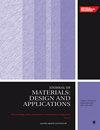竹屑与大理石粉填充陶瓷复合材料的物理性质研究:瓷砖生产的可持续方法
IF 2.2
4区 材料科学
Q3 MATERIALS SCIENCE, MULTIDISCIPLINARY
Proceedings of the Institution of Mechanical Engineers, Part L: Journal of Materials: Design and Applications
Pub Date : 2024-01-10
DOI:10.1177/14644207231225067
引用次数: 0
摘要
建议采用的竹子和大理石粉陶瓷系统具有卓越的品质。它对结晶相的构成有重大影响。这项研究无疑为有效利用竹粉开辟了道路,并为利用其他竹粉废料提供了有见地的信息。本研究提供了一种建造瓷砖的新方法,即用竹屑部分替代大理石粉作为原材料,从而充分利用东北部各州的竹屑。研究使用 X 射线粉末衍射和扫描电子显微镜来表征竹粉对不同成分比例的影响,以及竹粉对陶瓷砖的化学、矿物相和形态的影响。研究广泛考察了竹粉含量对宏观、微观和表面结构的影响。结果表明,在 1145 °C 下,竹粉含量为 8%、大理石粉含量为 4% 的样品的断裂模量达到 41.94 牛顿/平方毫米,而竹粉含量为 0%、大理石粉含量为 12% 的样品的断裂模量为 26.26 牛顿/平方毫米。此外,它的等效吸水率、失燃率和线性收缩率分别为 9.47%、13.68% 和 3.66%,超过了陶瓷砖的规格要求。本文章由计算机程序翻译,如有差异,请以英文原文为准。
Investigation of physical properties of bamboo dust with marble powder filled ceramic composites: Sustainable approach for ceramic tiles manufacturing
The suggested bamboo and marble dust ceramic systems can be credited with superior qualities. It has a significant impact on the makeup of the crystalline phase. This study unquestionably sets the road for the effective use of bamboo dust and offers insightful information regarding the use of other bamboo dust waste. The present study provided a novel way to construct the ceramic tile by employing bamboo dust to partially replace marble powder as raw material to utilize bamboo dust from the North Eastern States fully. X-ray powder diffraction and scanning electron microscope were used to characterize the impacts of bamboo dust on the various ingredient composition percentages on the chemistry, mineral phase, and morphology of the ceramic tiles made from bamboo dust. The effects of bamboo dust content on macro, microscopic-scale, and surface structures were extensively examined. Results showed that at 1145 °C, the rupture modulus of a sample containing 8% bamboo dust and 4% marble powder reached 41.94 N/mm2, while a sample with 0% bamboo dust and 12% marble powder reached 26.26 N/mm2. Additionally, it exceeds the specifications for ceramic tiles for its equivalent water absorption capacity, loss of ignition, and linear shrinkage, which were 9.47%, 13.68%, and 3.66%, respectively.
求助全文
通过发布文献求助,成功后即可免费获取论文全文。
去求助
来源期刊

CiteScore
4.70
自引率
8.30%
发文量
166
审稿时长
3 months
期刊介绍:
The Journal of Materials: Design and Applications covers the usage and design of materials for application in an engineering context. The materials covered include metals, ceramics, and composites, as well as engineering polymers.
"The Journal of Materials Design and Applications is dedicated to publishing papers of the highest quality, in a timely fashion, covering a variety of important areas in materials technology. The Journal''s publishers have a wealth of publishing expertise and ensure that authors are given exemplary service. Every attention is given to publishing the papers as quickly as possible. The Journal has an excellent international reputation, with a corresponding international Editorial Board from a large number of different materials areas and disciplines advising the Editor." Professor Bill Banks - University of Strathclyde, UK
This journal is a member of the Committee on Publication Ethics (COPE).
 求助内容:
求助内容: 应助结果提醒方式:
应助结果提醒方式:


